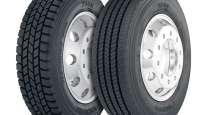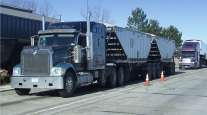Opinion: Lower Your Tire Costs With Proper Inflation
By Rick Phillips
Director, Commercial Sales
Yokohama Tire Corp.
This Opinion piece appears in the Oct. 29 print edition of Transport Topics. Click here to subscribe today.
It’s no secret that underinflated tires consume more fuel. Given that the price of diesel is rising more often than falling these days, today’s fleet maintenance managers must check tire pressure more regularly — and then actually do something about the results.
Unfortunately, too many fleets have adopted the “horseshoes” mentality, simply putting 100 psi in all tires, all positions, and hoping that — as with the old game of throwing horseshoes at a stake in the ground — just being “close enough” will do the job.
However, that philosophy is costing many fleets money because the tire’s inflation should match the actual load it’s carrying.
Imagine picking a vehicle and releasing the air from an inflated tire. What happens? The wheel drops to the ground. Conversely, when you reinflate that same tire, the wheel, the axle and the truck rise back up. That illustrates the simple fact that it’s not the tire that supports the truck and its cargo — it’s the air inside it.
Now imagine that same vehicle rolling down the highway. When in motion, the average commercial truck tire makes about 500 revolutions per mile. And with every revolution, the sidewalls flex under the load as the tire makes contact with road surface and then relaxes back to its normal, unloaded shape. This flexing process is called “deflection” and means that every tire on the vehicle is flexing and relaxing 500 times per mile. Now, consider 18 tires rolling at 60 mph — equal to one mile per minute — and that’s a staggering 9,000 deflections every minute.
Deflection is, of course, a normal phenomenon that occurs within a tire in motion. All tire companies and their engineers devote a large amount of time, effort, research and development to determine precisely how much and exactly where the tire should flex as it revolves under load.
Similar attention is paid to the shape of the footprint — the contact patch — of the tire as it makes contact with the road surface. The amount of deflection in the tire has a direct effect on the shape of the tire’s footprint, and a proper footprint is required to achieve the maximum performance from that tire.
An underinflated tire will have more deflection under the load and build up excessive heat, potentially causing premature failure. Conversely, an overinflated tire will be stiff and have less deflection, creating irregular wear, reduced tread life and a harsher ride. Both conditions distort the shape of the footprint, negating much of the technology and design by which the tire delivers optimized performance. In fact, in some extreme cases, improper inflation actually could cause the tire to fail while in operation.
Let’s look at loads and inflations. Say our typical 18-wheel truck and trailer are carrying a total of 80,000 pounds: 12,000 pounds on the steer axle, 34,000 pounds on the tandem drive axles and 34,000 pounds on the tandem trailer axles. If each of these tires is 100 psi, none would be correct. The steer axle is underinflated, and the drive and trailer tires are all overinflated.
Proper inflation is actually 110 psi for the steer axle and 80 psi for the drive and trailer axles.
Unfortunately, this scenario is not uncommon. Improper inflation affects the deflection and footprint of the tires during those 9,000 total revolutions per minute, resulting in irregular wear patterns at best — and total tire failure at worst.
These problems can be easily avoided with proper tire inflation. Below are additional disadvantages that underinflation and overinflation cause, plus tips on how to manage inflation pressure effectively for your fleet.
Disadvantages of underinflation include:
• Overloaded tires and, because a tire’s load capacity is determined largely by its inflation pressure, low air pressure can create a flatter and longer footprint while in contact with the road, making it run hotter.
• Additional stress on the tire’s internal structure, possibly leading to a tire failing during operation.
• Increased internal heat and rolling resistance, which reduce both fuel economy and tire life, and increasing the probability of irregular wear and premature failure.
• Loss of lateral stability and cornering performance.
The disadvantages of overinflation include:
• A stiffer, less flexible tire with the size of its footprint actually in contact with the road reduced, affecting the tire’s performance.
• Increased susceptibility to impact damage because the tire cannot properly flex to absorb impacts with road hazards.
• Increased likelihood of irregular wear patterns.
• Harsher rides and more noise transmitted into the vehicle’s interior.
And here are some tips about inflation pressure:
• Always check air pressure when the tire is cold, allowing at least four hours for the tire to cool down. A 10-degree change in temperature equates to a change of about 2 psi.
• Most manufacturers have inflation information on their websites, and some have data-driven calculators.
• Contact your local dealer and/or local manufacturer’s representative to answer any questions you may have.
Improper inflation causes many costly tire-related problems for fleets. If a tire’s performance is affected by 10% due to improper inflation, that’s a $40 cost on a $400 tire. In extreme cases, overall tire performance actually can be affected by as much as 25% to 30%, which is a significant financial cost to the bottom line.
So, while playing horseshoes is fun, the “close enough” approach to air pressure is not the best strategy for getting the most bang for the buck out of a fleet’s tire program.
Investing a little more time and effort in their maintenance practices — and correctly matching the tires’ inflation with the load — fleet managers will see a definite return on their investment with improved tire performance.
Yokohama Tire Corp., Fullerton, Calif., produces tires for the commercial truck and bus, off-the-road mining and construction applications and for the light truck and passenger car markets.




